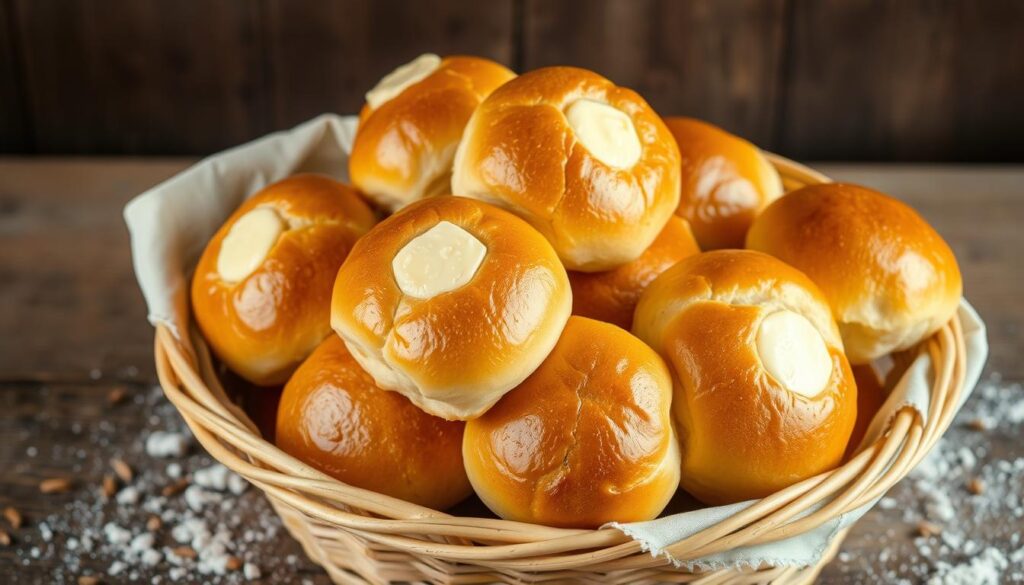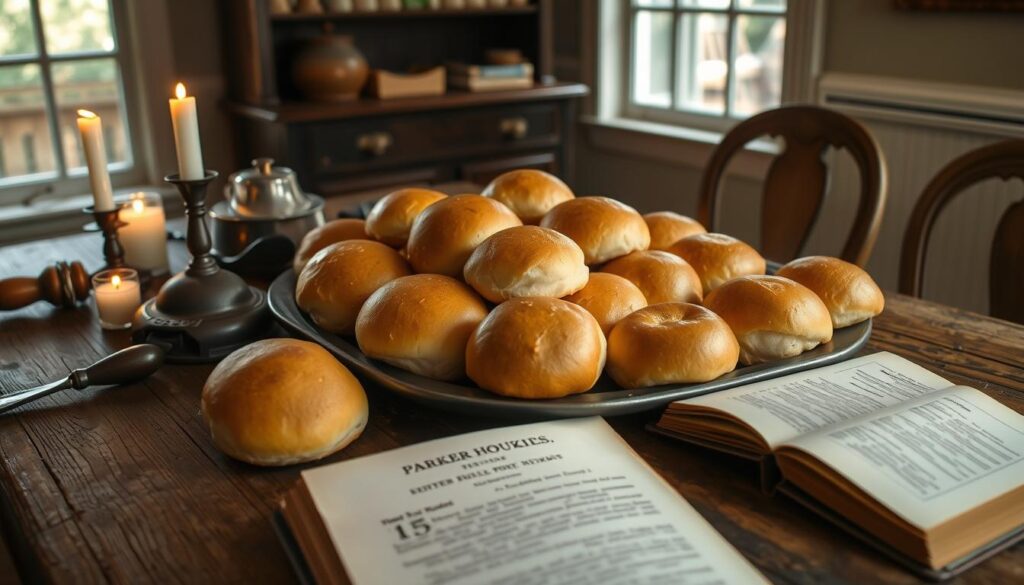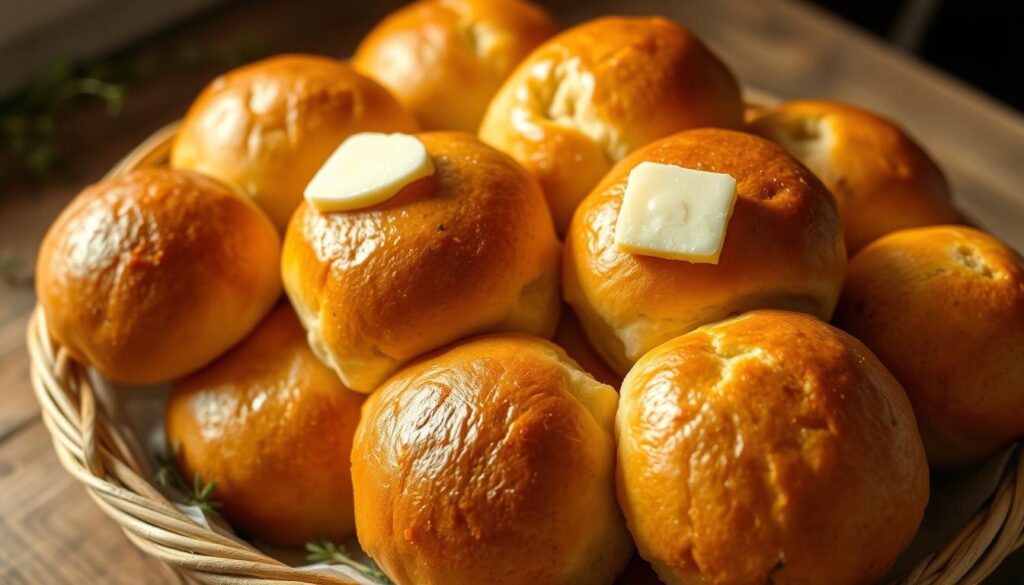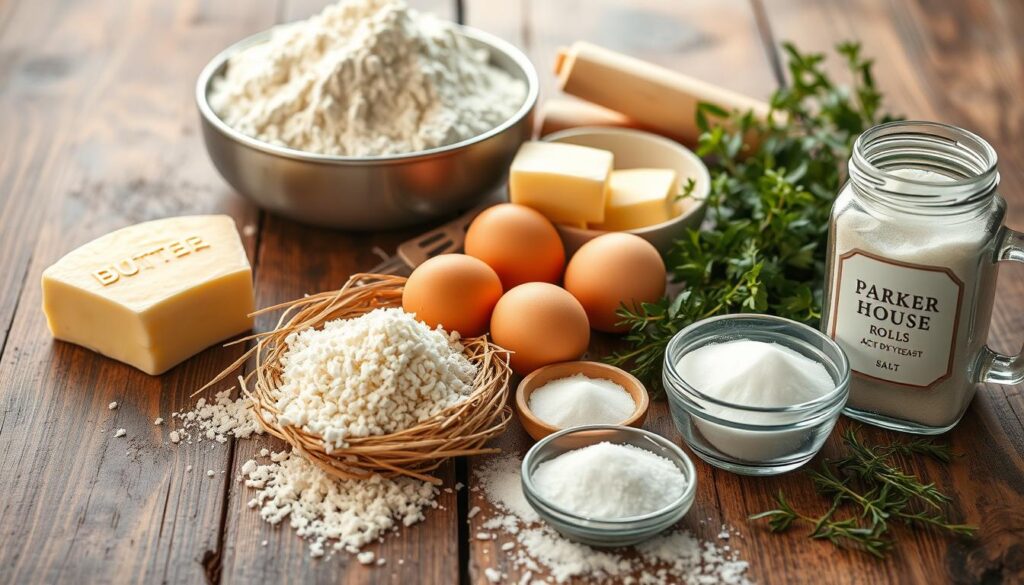Imagine the smell of fresh bread filling your home. Each Parker House roll is made with love, offering a crisp outside and a soft, buttery inside. These rolls are more than just food; they bring people together.
They’re perfect for any occasion, from holiday feasts to cozy family dinners. They remind us of homemade comfort and warmth. Picture sharing stories and laughter around the table, with these golden rolls as the centerpiece.
In this guide, we’ll explore the history of Parker House rolls. You’ll also learn how to make your own delicious, homemade rolls. It’s all about the journey and the joy of sharing a meal together.

Table of Contents
Key Takeaways
- Parker House Rolls can be shaped as 12 regular or 18 folded rolls.
- Each piece of dough should weigh approximately 45g for the best results.
- The total time for making, rising, and baking rolls is approximately 2 to 3 hours.
- Using a scale is highly recommended for accurate measurements.
- Yeast is essential for achieving that light and airy texture.
- These rolls can be stored in the fridge if they need to wait before baking.
Introduction to Parker House Rolls
Parker House Rolls are a delightful addition to any meal, known for their soft and buttery texture. They come from the iconic Omni Parker House hotel in Boston. These dinner rolls have become a staple in many homes.
The unique folding technique used in their preparation produces fluffy rolls. These rolls not only look appealing but also enhance the overall dining experience.
Making Parker House Rolls at home might seem intimidating, yet the process can be simple and rewarding. This recipe yields about 30 rolls. It requires just a few essential ingredients, including warm milk and active dry yeast.
Properly mixing 2 to 3 cups of flour with salt is crucial to achieving the perfect dough. Many enjoy shaping these rolls into twists or using a 2 to 2.5-inch cutter to create round shapes.

Once you master the art of these fluffy rolls, you will undoubtedly want to pair them with various dinner recipes. Whether served alongside a hearty stew or a festive holiday meal, Parker House Rolls provide the perfect complement. They make any meal special.
Storing leftover rolls is easy, as they can last for up to 3 days. This ensures that you can enjoy their buttery goodness long after the meal is over. Embracing the art of creating Parker House Rolls means unleashing a world of homemade bread perfection right in your kitchen.
History of Parker House Rolls
The Parker House rolls have a rich history. They started in the 1800s at the Parker House Hotel in Boston. Back then, soft, fluffy, and buttery rolls were unheard of.
In the 1870s, a German baker named Ward created the famous recipe. He used lots of butter to make the rolls moist and tender.
A fun story says the rolls’ unique fold was an accident. A chef threw dough at a wall, creating the fold. This made the rolls famous, even catching the eye of French composer Jacques Offenbach.
For a long time, the recipe was a secret. But, it was shared with Henrietta Nesbitt, the White House cook. This made the recipe public, appearing in the White House Cookbook.
By the 1880s, the recipe was shared more. Fannie Farmer included it in her 1896 book, The Boston Cooking-School Cook Book. Today, Parker House rolls are loved at holidays and family gatherings.

| Year | Significant Event |
|---|---|
| 1800s | Parker House Hotel established in Boston. |
| 1870s | Parker House roll recipe created by baker Ward. |
| 1880s | Recipe begins appearing in various cookbooks. |
| 1896 | Fannie Farmer includes Parker House rolls in her famous cookbook. |
What Makes the Best Parker House Rolls?
Finding the best Parker House rolls involves a few key elements. The rolls’ buttery taste is a big deal. Using top-notch ingredients like Land O Lakes butter makes them rich and indulgent. It’s also important to use fresh ingredients, like King Arthur unbleached all-purpose flour and bread flour, for the best results.
The rolls’ fluffy texture is another key feature. Getting this right means paying close attention to how you knead and let the dough rise. The perfect roll is soft and rises well. A study with 27 tasters showed that using potato flakes makes the rolls tender and moist.

Don’t forget about salt in making perfect rolls. Diamond kosher salt adds depth to the flavor, making the rolls taste balanced. The type of yeast used is also crucial; both SAF Red Instant Yeast and Red Star Active Dry Yeast worked well in different recipes. Sugar helps the yeast work and adds to the rolls’ golden color.
The way you shape the rolls is important too. This method not only makes them look great but also keeps them moist. With the right ingredients and attention to detail, you can make Parker House rolls that everyone will love.
| Ingredient | Purpose |
|---|---|
| Land O Lakes Butter | Adds richness and flavor |
| King Arthur Flour | Provides structure |
| Sugar (Imperial Granulated) | Enhances sweetness and browning |
| Potato Flakes | Contributes to a fluffy texture |
| Diamond Kosher Salt | Balancing flavors |
| SAF Red Instant Yeast | Activates dough rise |
| Borden Whole Milk | Adds moisture and richness |
Parker House Rolls Recipe
Making perfect Parker House rolls needs careful attention to ingredients and baking tools. This guide will help you make a delicious Parker House rolls recipe. It will impress your family and friends.
Essential Ingredients for Perfect Rolls
Quality ingredients are key for great Parker House rolls. Here’s what you need:
- 4 1/2 cups (630g) all-purpose flour
- 1 1/2 cups (355ml) whole milk
- 3 tablespoons unsalted butter
- 3 tablespoons sugar
- 2 teaspoons salt
- 2 1/4 teaspoons (1 envelope) active dry yeast
- 3 tablespoons lukewarm water
Each ingredient is crucial. For example, unsalted butter lets you control the salt. This makes the rolls taste just right.
Equipment Needed for Baking
Having the right baking tools makes the process easier. Here’s what you’ll need:
- Mixing bowls
- Measuring cups and spoons
- Food scale for accuracy
- Rolling pin
- Baking sheets lined with parchment paper
With these tools, making Parker House rolls becomes a breeze. Your recipe will turn out delicious.

| Ingredient | Quantity | Purpose |
|---|---|---|
| All-Purpose Flour | 4 1/2 cups | Provides structure |
| Whole Milk | 1 1/2 cups | Keeps rolls moist |
| Unsalted Butter | 3 tablespoons | Adds flavor |
| Sugar | 3 tablespoons | Enhances browning |
| Salt | 2 teaspoons | Balances flavor |
| Active Dry Yeast | 2 1/4 teaspoons | Leavening agent |
| Lukewarm Water | 3 tablespoons | Activates yeast |
Step-by-Step Instructions for Making Parker House Rolls
Making Parker House rolls is easy. You just need to mix, knead, and bake. Here’s a simple guide to help you make these treats.
Preparing the Dough
First, get your ingredients ready. You’ll need 1 1/4 cups of whole milk, 1/3 cup of sugar, and 2 1/4 teaspoons of yeast. Also, 6 oz. of unsalted butter, 2 large eggs, 4 1/2 cups of flour, and 2 teaspoons of salt. Warm the milk to 110°F to help the yeast.
In a big bowl, mix the sugar into the warm milk. Then add the yeast. Wait 5-10 minutes for it to get bubbly. Next, add the butter and eggs. Mix in the flour and salt slowly until a dough forms.
Knead the dough for 5-7 minutes until it’s smooth. Put it in a greased bowl, cover it, and let it rise in a warm place for 1 hour. It should double in size.
Shaping the Rolls
After rising, punch down the dough to get rid of air. Cut it into 24 equal pieces. Roll each into a ball, flatten it, brush with butter, and fold it in half. Or, just roll them into balls for round shapes.
Put the rolls in a greased 13- x 9-inch pan, touching each other. Cover and let them rise for 30-45 minutes. Preheat your oven to 350°F. Bake for 28-30 minutes until they’re golden. Let them cool for 10 minutes before serving.
Tips for Fluffy Parker House Rolls
To get fluffy Parker House rolls, follow some key tips. First, make sure your yeast is fresh and active. This is key for a light, airy texture. Start by mixing 1 and 1/2 tablespoons of active dry yeast with 2 teaspoons of sugar, 1/4 cup of warm water, and 1 cup of milk heated to 105-110°F.
Give your dough enough time to rise. The first rise should take 60-90 minutes, until it doubles. Then, shape your rolls and let them rise again for 45 minutes. This step makes them even fluffier.
Getting the right flour moisture is also important. When kneading, keep the dough temperature right. Avoid overkneading to prevent dense rolls. Lightly flouring your work surface helps keep the dough right without adding too much flour.
Here’s a quick overview of some best practices for baking rolls:
- Use high-quality, fresh yeast.
- Allow for ample proofing time to develop airiness.
- Maintain a warm environment for dough rising.
- Brush with melted butter right after baking.
- Sprinkle flaky sea salt before serving for added flavor.
By following these tips, you can make light, fluffy, and delicious Parker House rolls.
How to Store and Freeze Parker House Rolls
Keeping your rolls fresh and tasty is key. Store homemade rolls in an airtight container at room temperature. This way, they stay fresh for 5 to 6 days, thanks to the potato flakes.
For longer storage, freeze Parker House rolls. Wrap each roll in plastic wrap and then in a zip-lock bag. This keeps moisture in and prevents freezer burn. Frozen rolls can last up to two months. But for the best taste, use them in 2 to 3 weeks.
To reheat, just put them in the oven for a few minutes. This brings back their softness. By following these steps, you’ll always have delicious rolls ready for any time.
Serving Suggestions for Parker House Rolls
Parker House rolls are more than just a tasty addition to your meal. They are a versatile side dish that goes well with many flavors. Whether it’s a big celebration or a small dinner, these rolls add something special to your table.
Try serving Parker House rolls with roasted meats like turkey or beef. They pair well, making both the roll and the meat taste even better. They’re also great for soaking up the juices from stews and soups, perfect for cold nights.
For something different, try them with unique spreads. Garlic herb butter adds a savory flavor, while honey or fruit preserves bring a sweet touch. You can even use them as sliders with leftover turkey or ham for a fun twist.
Here’s a brief overview of different serving suggestions for Parker House rolls:
| Pairing Option | Description |
|---|---|
| Roasted Meats | Great for soaking up savory juices, enhancing the overall meal |
| Hearty Soups & Stews | A perfect side to balance warmth with a fluffy texture |
| Garlic Herb Butter | Spreadable option for an elevated taste during meals |
| Honey or Jam | Add a sweet element to contrast with savory choices |
| Leftover Sliders | Creative way to utilize rolls as sandwiches filled with turkey or ham |
Try out these ideas for serving Parker House rolls and find your favorites. Whether as a main appetizer or a side dish, these rolls are sure to impress anyone.
Variations of Parker House Rolls
Parker House rolls are a great base for many creative recipes. You can add different flavors to make them special for any event. Try adding roasted garlic, cheddar cheese, or fresh herbs like rosemary to give them a unique taste. These changes keep the rolls’ classic taste while adding something new.
Playing with fillings can also be fun. Imagine rolls with savory herb butter or sweet honey butter. These rolls make great brunch items or fun appetizers that wow your guests.
Here’s an overview of some popular variations:
| Variation | Key Ingredients | Notes |
|---|---|---|
| Cheddar Herb Rolls | Cheddar cheese, rosemary | Rich and cheesy flavor, perfect for pairing with soups. |
| Garlic Parmesan Rolls | Roasted garlic, parmesan cheese | A savory option that brings umami to the table. |
| Honey Butter Rolls | Honey, cinnamon | A sweet variation ideal for breakfast. |
| Mini Sandwich Rolls | Deli meats, cheese | Great for entertaining; fill with your favorite ingredients. |
With these Parker House roll variations, you can make tasty treats for everyone. Whether you prefer savory or sweet, adding different flavors makes meals more enjoyable. Don’t be afraid to try these creative recipes in your kitchen!
The Science Behind Parker House Rolls
Learning about the science of baking rolls can really help you in the kitchen. At the core of Parker House rolls is yeast fermentation. This is a key process for getting the right texture and rise. When you mix warm milk with instant yeast, the yeast starts to work. It eats sugars and makes carbon dioxide, which makes the dough rise and become fluffy when baked.
As the dough rises, gluten development in bread is also important. Gluten is a network of proteins that makes the dough elastic and strong. When you knead the dough, these proteins stretch and get stronger. This lets the dough hold the gas bubbles made during fermentation. The mix of yeast fermentation and gluten development makes your dough into perfect, light rolls.
The buttery coating on Parker House rolls adds moisture and flavor. This mix of ingredients creates a comforting and satisfying experience. As you try out your recipe, remember these scientific principles. They can help you get even better results in your baking.
Common Mistakes to Avoid in Roll Making
Making Parker House rolls can be easy, but mistakes can happen. Knowing these common errors and how to avoid them will make your baking better. Here are some mistakes and tips for perfect rolls:
- Expired Yeast: Always check the use-by date on your yeast package. Expired yeast loses effectiveness and results in flat rolls.
- Excess Salt: Adding too much salt can slow down the dough’s rise, making it dense. Maintain the right balance.
- Overmixing Dough: Flour high in protein can lead to tough rolls if overmixed. Mix just until combined for the best texture.
- Achieving Workable Dough: The dough should be neither sticky nor dry. Finding this balance is crucial for rolling out perfectly round dinner rolls.
- Unequal Portions: Divide your dough into equal pieces. This ensures uniformity and even baking across all rolls.
- Egg Wash: Brushing the tops with an egg wash before baking gives your rolls a golden shine and helps toppings stick.
- Using a Slow Cooker: Making rolls in a slow cooker reduces the risk of burning and opens up oven space for other dishes.
By avoiding these common mistakes and following the right techniques, you can make your Parker House rolls amazing! Mastering these details will take your rolls from simple to sensational!
| Mistake | Impact on Rolls | Solution |
|---|---|---|
| Expired Yeast | Flat rolls | Check use-by dates regularly. |
| Too Much Salt | Slow rise | Follow the recipe carefully. |
| Overmixing Dough | Tough texture | Mix just until combined. |
| Improper Dough Texture | Baking difficulties | Aim for a smooth, workable consistency. |
| Unequal Dough Portions | Inconsistent baking | Use a scale for accurate measurement. |
| Skipping Egg Wash | Pale rolls | Always apply egg wash before baking. |
| Not Using Slow Cooker | Increased risk of burning | Consider slow cooker for easier baking. |
Conclusion
Learning to make Parker House rolls can really boost your baking skills. These rolls, first made in the 1870s, are loved for their rich buttery taste and soft texture. They add a special touch to any meal.
By following the tips and tricks in this article, you can make these classic rolls at home. You’ll learn how to make them as good as those from a bakery. Every step, from mixing the dough to baking, is important to get it right.
Remember, baking rolls is all about practice. It’s not just about the ingredients, but also the techniques that make them perfect. With a bit of effort and the right methods, you’ll be able to impress your guests with these delicious rolls.
F.A.Q
What are Parker House rolls?
Parker House rolls are soft, buttery dinner rolls. They have a unique folded shape. They come from the Parker House Hotel in Boston and are loved for their fluffy texture and rich flavor.
How do I make Parker House rolls at home?
To make Parker House rolls at home, you need flour, yeast, sugar, salt, milk, butter, and eggs. Follow a recipe that guides you through mixing, kneading, letting the dough rise, shaping, and baking until they’re golden.
What should I do if my Parker House rolls are dense?
Dense rolls might come from overproofing or using cold ingredients. Make sure your yeast is fresh and active. Let the dough rise enough and avoid overkneading for fluffy rolls.
Can I freeze Parker House rolls?
Yes, you can freeze Parker House rolls. Wrap each roll in plastic wrap and put them in a zip-lock bag for up to three months. To reheat, bake them in the oven for a few minutes.
What are some variations I can make with Parker House rolls?
You can add herbs, cheese, or spices to the dough for new flavors. Try roasted garlic, cheddar cheese, or rosemary to enhance the traditional taste while keeping the classic roll’s feel.
What are the essential ingredients for making Parker House rolls?
You need flour, yeast, sugar, salt, milk, butter, and eggs. Each ingredient adds to the rolls’ rich taste and fluffy texture.
How should I store Parker House rolls for maximum freshness?
Keep Parker House rolls in an airtight container at room temperature for 3-4 days. Freezing is best for longer storage.
What equipment do I need to bake Parker House rolls?
You’ll need mixing bowls, measuring cups and spoons, a rolling pin, baking sheets with parchment paper, and a food scale. The right tools help you get better results.
What is the history behind Parker House rolls?
Parker House rolls started in the 1870s at the Parker House Hotel in Boston. A tired baker’s folding method turned undercooked rolls into the fluffy, buttery treats we enjoy today.
What are some serving suggestions for Parker House rolls?
Parker House rolls go well with roasted meats, stews, and soups. Try them with garlic herb butter, honey, or jam for a nice contrast. Or use them as sliders for leftover turkey or ham.



